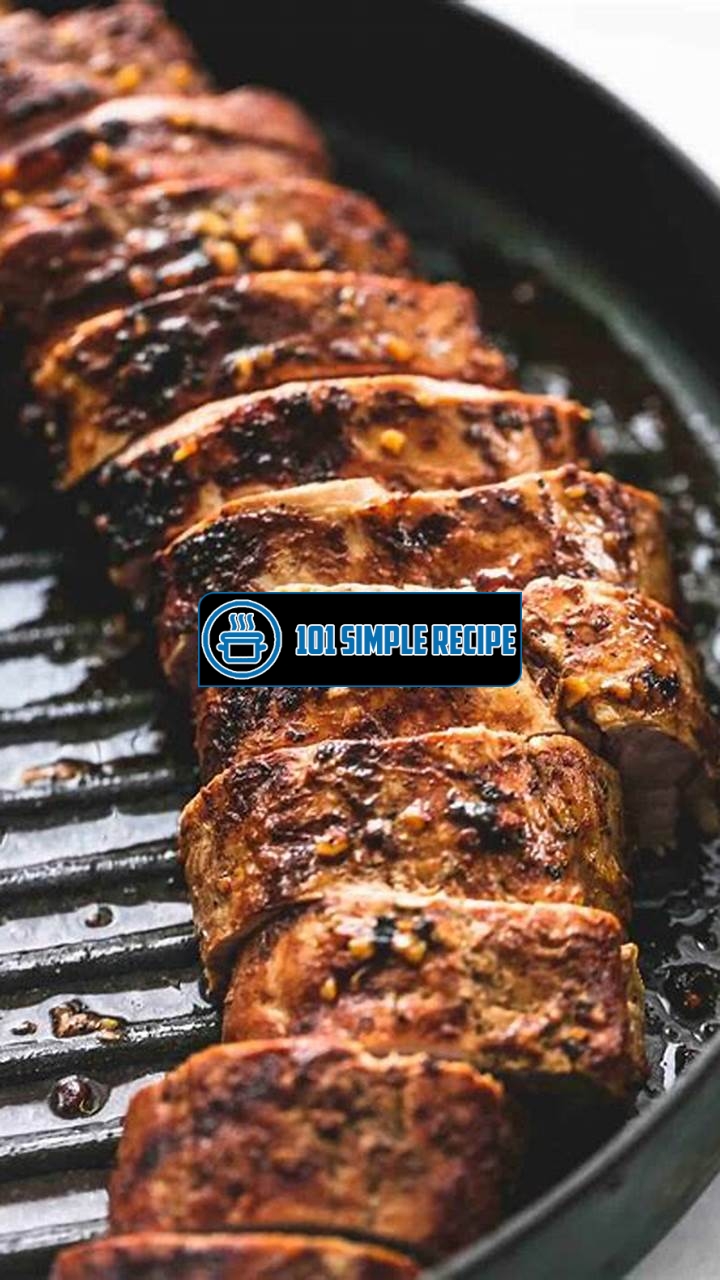Are you someone who enjoys indulging in a succulent cut of pork tenderloin? While it may be tempting to savor every bite, you might have wondered whether pork tenderloin is truly a healthy choice. In this article, we will delve into the nutritional value of pork tenderloin and explore its potential health benefits, so you can make an informed decision about including it in your diet. So, let’s examine the facts and debunk any misconceptions surrounding this popular meat.

Understanding the Nutritional Profile of Pork Tenderloin
Pork tenderloin, a popular cut of meat derived from the loin of a pig, is not only delicious but also packed with essential nutrients that can contribute to a healthy diet. Understanding the nutritional profile of pork tenderloin can help you make informed choices about incorporating it into your meals.
Nutritional Composition of Pork Tenderloin
Pork tenderloin is a lean and protein-rich food that offers numerous health benefits. A 3-ounce serving of cooked pork tenderloin provides approximately 22 grams of protein and only 3 grams of fat, making it an excellent choice for those looking to maintain or build muscle mass. It is also a great source of several important vitamins and minerals.
One of the key nutrients found in pork tenderloin is vitamin B12, which plays a vital role in maintaining a healthy nervous system and producing red blood cells. Additionally, it contains significant amounts of vitamin B6, which supports brain development and function. These vitamins are essential for overall well-being and vitality.
Moreover, pork tenderloin is an excellent source of selenium, an essential trace mineral with potent antioxidant properties. This mineral helps protect against oxidative stress and plays a crucial role in immune function, thyroid health, and DNA synthesis.
Health Benefits of Pork Tenderloin
The consumption of pork tenderloin can provide various health benefits due to its impressive nutritional profile. Including it in your diet can help support muscle growth, improve brain function, boost immunity, and promote overall well-being.
Protein, found abundantly in pork tenderloin, is a crucial macronutrient that aids in building and repairing body tissues. It supports muscle growth, increases satiety, and assists in weight management, making pork tenderloin a fantastic option for individuals following a high-protein diet or looking to lose weight.
The presence of vitamin B6 in pork tenderloin is beneficial for brain health. This vitamin aids in the production of neurotransmitters that regulate mood, memory, and cognitive function. Regular consumption of pork tenderloin can help improve mental performance and reduce the risk of cognitive decline.
Furthermore, the selenium content in pork tenderloin contributes to a strong immune system by neutralizing harmful free radicals in the body. It also supports an optimal thyroid function, playing a critical role in regulating metabolism and energy production.
Recommended Serving Size and Portion Control
When it comes to consuming pork tenderloin, portion control is essential to enjoy its benefits without overindulging. The recommended serving size for pork tenderloin is around 3-4 ounces, which provides an appropriate balance of nutrients for most individuals.
It is important to note that while pork tenderloin is a healthy meat option, it is still calorie-dense. Therefore, paying attention to portion sizes and incorporating it into a well-balanced diet is key. Pairing it with a variety of vegetables and whole grains can create a nutritious and satisfying meal.
Remember, moderation is key when incorporating pork tenderloin into your diet. Be mindful of your portion sizes and choose lean cuts to maximize the health benefits it has to offer.
In conclusion, pork tenderloin offers a variety of health benefits, thanks to its nutritional composition. It is a lean source of protein, rich in essential vitamins and minerals like vitamin B12, vitamin B6, and selenium. By practicing portion control and incorporating it into a balanced diet, you can enjoy the flavors and benefits that pork tenderloin has to offer.
Pork Tenderloin and Heart Health
Pork tenderloin is a popular choice when it comes to healthy eating. It is often considered to be a lean and nutritious option for meat lovers. But what exactly is the relationship between pork tenderloin consumption and heart health? Let’s explore the facts.
Pork Tenderloin and Cholesterol
Many people wonder if pork tenderloin is high in cholesterol. The good news is that it is relatively low in cholesterol compared to other cuts of pork. A 3-ounce serving of pork tenderloin contains just 55 milligrams of cholesterol, which is significantly lower than the recommended daily limit of 300 milligrams for individuals without heart disease. So, if you are watching your cholesterol intake, pork tenderloin can be a suitable choice.
It’s also important to note that the cholesterol content in pork tenderloin is mainly found in the fat marbling. Therefore, trimming off any visible fat before cooking can further reduce the cholesterol levels in the meat.
Pork Tenderloin and Fat Content
When it comes to the fat content in pork tenderloin, it is a relatively lean cut of meat. In fact, it is considered one of the leanest cuts of pork available. A 3-ounce serving of pork tenderloin typically contains only about 3 grams of fat. Compared to other popular cuts of pork like bacon or ribs, pork tenderloin is a much healthier option.
It’s worth highlighting that the fat in pork tenderloin is primarily unsaturated fat, which is considered heart-healthy. Unsaturated fats have been shown to lower bad cholesterol levels and reduce the risk of heart disease when consumed in moderation.
Lean Cuts of Pork Tenderloin for a Heart-Healthy Diet
To ensure that you are making the healthiest choices when it comes to pork tenderloin, it’s essential to opt for lean cuts. Look for pork tenderloin that has minimal visible fat and marbling. Fresh, unprocessed cuts are generally the best options for a heart-healthy diet.
Remember to trim off any excess fat before cooking and choose cooking methods that require minimal added fats. Grilling, baking, or roasting are all excellent choices for preparing pork tenderloin without adding unnecessary calories or unhealthy fats.
- Eat lean cuts of pork tenderloin to reduce fat intake.
- Trim off visible fat before cooking.
- Choose cooking methods that require minimal added fats.
- Grill, bake, or roast pork tenderloin for a heart-healthy meal.
Note:
Moderation is key when it comes to including pork tenderloin in a heart-healthy diet. It is advisable to consume a variety of lean proteins and incorporate plenty of fruits, vegetables, and whole grains into your meals for a well-rounded and balanced diet.
In conclusion, while pork tenderloin can be a healthy choice for meat lovers, it’s crucial to pay attention to the cuts, fat content, and cholesterol levels. By selecting lean cuts and preparing them in a mindful and heart-healthy way, you can enjoy the deliciousness of pork tenderloin while prioritizing your heart health.
Pork Tenderloin and Weight Management
When it comes to weight management, incorporating pork tenderloin into your diet can be a smart move. This lean cut of meat offers a range of health benefits that can support your weight loss goals. By understanding how pork tenderloin fits into a balanced weight management plan, you can make informed choices about your meals.
Pork Tenderloin as a Source of Lean Protein
Pork tenderloin is an excellent source of lean protein, which is an essential nutrient for weight management. Protein helps to build and repair tissues, supports the immune system, and provides a feeling of fullness. Compared to other cuts of pork, tenderloin is lower in fat and calories but packed with protein.
Including pork tenderloin in your meals can help you meet your daily protein needs without adding excessive calories and fats. This is particularly beneficial for weight management, as a higher protein intake often leads to increased satiety and reduced calorie consumption throughout the day.
Satiety and Pork Tenderloin
Another noteworthy benefit of pork tenderloin is its effect on satiety, or the feeling of fullness after a meal. Protein-rich foods like pork tenderloin can help you stay satisfied for longer periods, reducing the temptation to snack between meals or overeat during regular meal times.
️ By incorporating pork tenderloin into your meals, you can promote feelings of fullness and reduce the likelihood of overeating or consuming unhealthy snacks. This can be especially beneficial for weight management, as it supports portion control and helps you stick to your calorie goals. ️
Incorporating Pork Tenderloin into Balanced Meals
Now that you understand the weight management benefits of pork tenderloin, it’s time to explore how you can incorporate this flavorful meat into your balanced meals.
- Add sliced pork tenderloin to a colorful salad packed with fresh vegetables and a light vinaigrette dressing for a nutritious and satisfying lunch option.
- Grill or roast pork tenderloin and pair it with steamed vegetables and a small portion of whole grains for a well-rounded dinner.
- Create a tasty stir-fry by sautéing thinly sliced pork tenderloin with an assortment of colorful vegetables and a splash of low-sodium soy sauce.
- Make a protein-rich breakfast by adding diced pork tenderloin to an omelet or scramble, alongside fresh herbs and vegetables.
️ By incorporating pork tenderloin into these balanced meal options, you can enjoy a wide variety of flavors while supporting your weight management goals. Remember to keep portion sizes in mind and focus on including plenty of fruits, vegetables, and whole grains to create a well-balanced plate. ️
As you can see, pork tenderloin can be a healthy addition to your weight management plan. It serves as a lean source of protein, promotes feelings of fullness, and can be easily incorporated into a range of balanced meals. By making smart choices and including pork tenderloin in your diet, you can support your weight loss goals while enjoying delicious and nutritious meals. So go ahead, give pork tenderloin a try and discover the benefits it brings to your weight management journey!
Quality Factors of Pork Tenderloin
When it comes to enjoying pork tenderloin as part of a healthy diet, selecting high-quality cuts is crucial. Optimal health benefits can be achieved by understanding the importance of quality factors in pork tenderloin. Let’s explore the key elements to consider when choosing your pork tenderloin:
Grass-Fed vs Grain-Fed Pork Tenderloin
One important factor to consider is whether the pork tenderloin comes from grass-fed or grain-fed pigs. Grass-fed pork tenderloin is believed to offer superior health benefits due to its higher omega-3 fatty acid content. These healthy fatty acids have been linked to reducing the risk of heart disease and improving brain function. On the other hand, grain-fed pork tenderloin tends to be more marbled and offers a richer flavor. However, it may also have higher saturated fat content and fewer omega-3s. Therefore, if you prioritize health benefits, opting for grass-fed pork tenderloin is recommended.
Organic and Antibiotic-Free Pork Tenderloin
In addition to considering the feeding regimen of the pigs, it is also essential to look for organic and antibiotic-free pork tenderloin. Choosing organic pork ensures that the pigs were raised without the use of synthetic pesticides, herbicides, or genetically modified organisms (GMOs) in their feed. This can minimize your exposure to potentially harmful chemicals. Furthermore, selecting antibiotic-free pork tenderloin reduces the risk of consuming antibiotics that might be present in conventionally raised pigs. It is worth noting that some studies suggest a link between antibiotic overuse in animal agriculture and antibiotic resistance in humans.
Certifications and Labels for Pork Tenderloin
When browsing for pork tenderloin, keep an eye out for different certifications and labels. USDA Organic certification is a reliable indicator that the pork comes from pigs raised on organic feed, without antibiotics or growth hormones. The American Grassfed Association (AGA) certification assures that the pork comes from animals that only consumed a grass-based diet. Another label to consider is Animal Welfare Approved or Certified Humane, which ensures that the pigs were raised in humane conditions. These certifications and labels can provide peace of mind in knowing that the pork tenderloin meets specific standards.
It is important to note that while these quality factors can contribute to a healthier pork tenderloin, the overall healthiness of your diet depends on various factors. It is always recommended to maintain a balanced and varied diet.
In conclusion, selecting high-quality pork tenderloin is key to ensuring optimal health benefits. By choosing grass-fed over grain-fed pork, organic and antibiotic-free options, and looking for relevant certifications and labels, you can make informed decisions about your pork tenderloin purchase. Remember to prioritize your health and enjoy this flavorful cut as part of a balanced diet.
Cooking Methods for Pork Tenderloin
When it comes to pork tenderloin, the cooking method you choose can greatly impact its taste and healthiness. By experimenting with different techniques, you can unlock a world of flavors while still keeping your meal nutritious. In this article, we will explore three popular cooking methods for pork tenderloin: grilling, baking, and sautéing/stir-frying.
Grilling Pork Tenderloin
Grilling is a favorite cooking method for many pork aficionados. Not only does it impart a smoky flavor to the meat, but it also allows excess fat to drip away, resulting in a leaner dish.
To grill pork tenderloin, start by preheating your grill to medium-high heat. Season the meat with your preferred blend of spices and place it directly on the grill grates. Cook for about 15-20 minutes, flipping halfway through, until the internal temperature reaches 145°F (63°C).
Grilling tip: For an extra burst of flavor, marinate the pork tenderloin overnight before grilling. This will enhance the taste and tenderness of the meat.
Baking Pork Tenderloin
Baking is a convenient and fuss-free way to cook pork tenderloin. It allows for even cooking and requires minimal supervision, making it an ideal choice for busy individuals.
To bake pork tenderloin, preheat your oven to 425°F (220°C). Season the meat with your desired herbs and spices, then place it on a baking sheet lined with parchment paper. Bake for approximately 20-25 minutes, or until the internal temperature reaches 145°F (63°C).
Baking tip: For added moisture and flavor, wrap the pork tenderloin in bacon before baking. The bacon fat will help keep the meat juicy and deliver an irresistible smoky taste.
Sautéing and Stir-Frying Pork Tenderloin
Sautéing and stir-frying are quick and versatile cooking methods that allow you to infuse your pork tenderloin with vibrant flavors. These techniques involve high heat and constant tossing, resulting in tender and succulent meat.
To sauté or stir-fry pork tenderloin, start by slicing the meat into thin strips. Heat a tablespoon of oil in a skillet or wok over medium-high heat. Add the pork and cook for about 3-4 minutes, or until it’s no longer pink in the center.
Sautéing/stir-frying tip: Amp up the taste by using a flavorful sauce, such as teriyaki or soy, to coat the pork tenderloin during cooking. This will add an extra layer of deliciousness to your dish.
By exploring these different cooking methods – grilling, baking, and sautéing/stir-frying – you can transform a simple pork tenderloin into a delectable and healthy masterpiece. Get creative with flavors, experiment with marinades and sauces, and enjoy the versatility that this tender cut of meat offers.
Frequently Asked Questions
If you have any more questions about whether or not pork tenderloin is healthy, take a look at the FAQs below:
| No. | Questions | Answers |
|---|---|---|
| 1. | Is pork tenderloin a lean meat? | Yes, pork tenderloin is considered a lean meat with low fat content. It can be a healthier choice compared to fattier cuts of pork. |
| 2. | Is pork tenderloin high in protein? | Indeed, pork tenderloin is a good source of protein. It provides essential amino acids necessary for various bodily functions. |
| 3. | Can pork tenderloin be part of a balanced diet? | Absolutely! Pork tenderloin can be included as a healthy protein option in a well-balanced diet that includes a variety of nutrients. |
| 4. | Does pork tenderloin provide essential vitamins and minerals? | Yes, pork tenderloin contains various vitamins and minerals like iron, zinc, and B vitamins that are important for overall health. |
| 5. | What is the recommended portion size for pork tenderloin? | A recommended portion size for pork tenderloin is about 3-4 ounces, which provides a good balance of nutrients without excessive calories. |
| 6. | Can pork tenderloin be prepared in a healthy way? | Certainly! Pork tenderloin can be cooked using healthy methods such as grilling, roasting, or sautéing with minimal added fats or oils. |
Thanks for Reading!
Thank you for taking the time to read this article about the health benefits of pork tenderloin. We hope you found the information helpful and informative. If you have any more questions or if there are any other topics you’d like us to cover, please feel free to visit our website again in the future. Stay healthy and enjoy your culinary adventures!
Jump to Recipe
Healthy Pork Tenderloin Recipe

Discover a delicious and healthy pork tenderloin recipe that will satisfy your taste buds and provide essential nutrients. Perfect for any occasion.
- 1 lb pork tenderloin
- 2 cloves garlic (minced)
- 1 tsp dried thyme
- 1 tsp dried rosemary
- 1 tsp paprika
- 1/2 tsp salt
- 1/4 tsp black pepper
- 1 tbsp olive oil
- Preheat the oven to 400°F (200°C) and line a baking sheet with parchment paper.
- In a small bowl, combine the minced garlic, dried thyme, dried rosemary, paprika, salt, and black pepper. Rub this mixture all over the pork tenderloin to season it evenly.
- Heat the olive oil in a large oven-safe skillet over medium-high heat. Add the seasoned pork tenderloin to the skillet and sear it for 2-3 minutes on each side until golden brown.
- Transfer the skillet with the seared pork tenderloin to the preheated oven and roast it for around 15-20 minutes or until the internal temperature reaches 145°F (63°C).
- Remove the pork tenderloin from the oven and let it rest for a few minutes before slicing it into thin medallions. Serve it with your favorite side dishes and enjoy!






